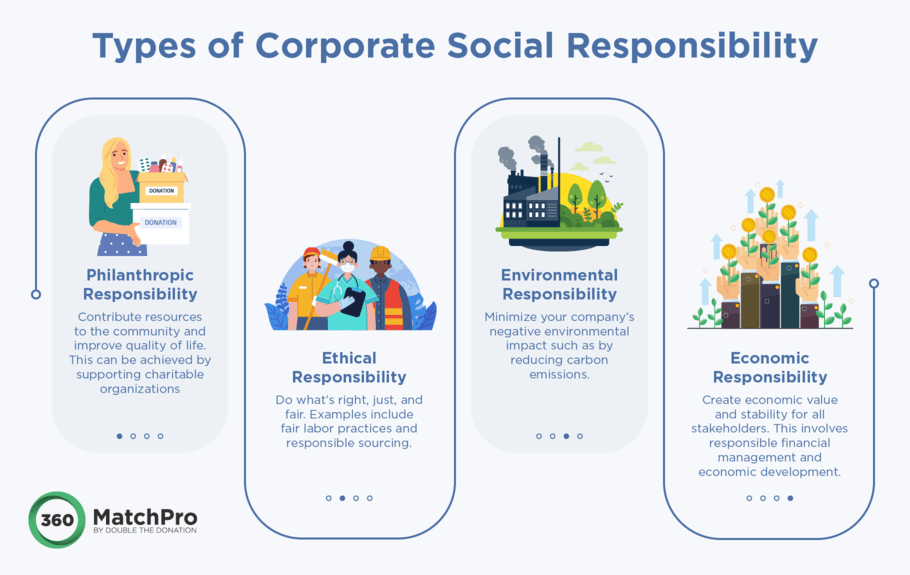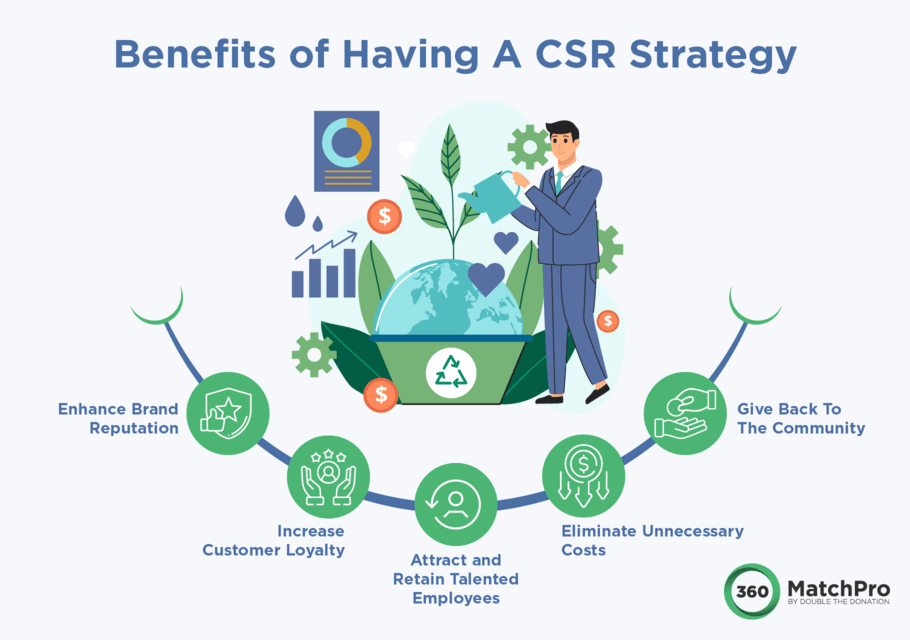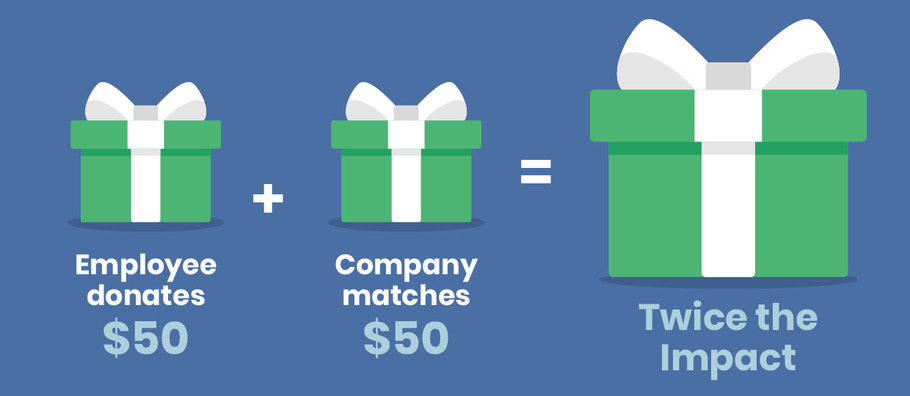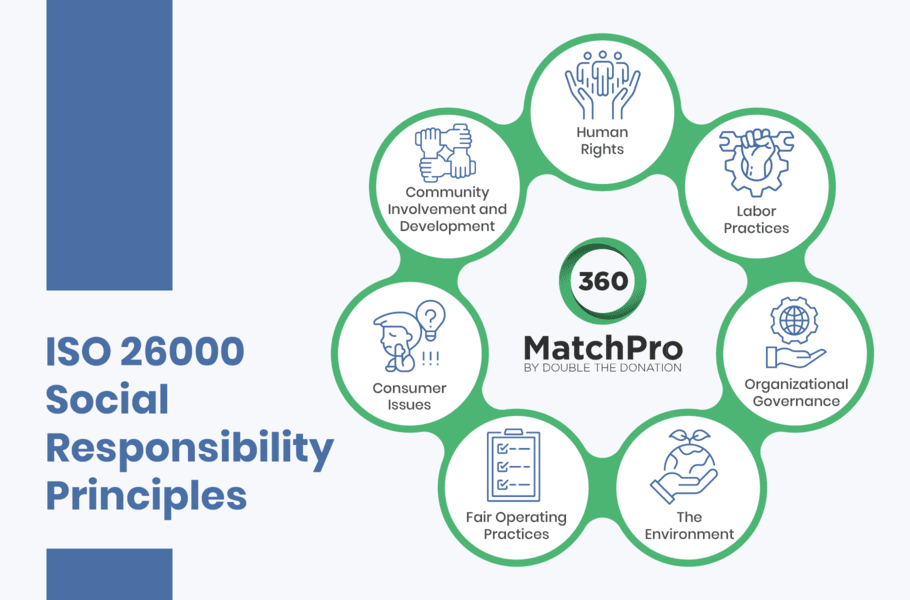Developing A CSR Strategy: 13 Tips For Smart Companies
Imagine a world where your business not only thrives but also serves as a catalyst for positive change. This is the vision of a purpose-driven business, where profitability and societal impact go hand in hand. With a thoughtful corporate social responsibility (CSR) strategy, your company can become a true changemaker.
Developing a CSR strategy comes with challenges, however. From sustainability goals to ethical practices, you’re faced with several choices for how to drive change. While this can be daunting, remember that you stand to gain a lot if you create a meaningful corporate giving program.
Whether you’re designing your company’s first CSR strategy or overhauling an existing plan, this guide will share everything you need to know to create initiatives that ignite true change. Here’s what you’ll learn:
- What Is A CSR Strategy?
- What Are The Different Types of CSR?
- Why Should My Company Develop A CSR Strategy?
- What Tips Should I Follow When Developing A CSR Strategy?
- What Are Some CSR Strategy Examples?
A thoughtful CSR strategy can set your company up for long-term success, whether you’re striving to recruit talented employees, strengthen customer relations, or simply give back to your community. Let’s dive into the basics.
What is a CSR Strategy?
A CSR strategy is a comprehensive plan developed by a company to guide its corporate social responsibility initiatives and activities. In essence, CSR involves a company’s commitment to addressing social and environmental issues through philanthropy and its business operations to positively impact society.
A CSR strategy encompasses the company’s goals, values, and objectives related to responsible business practices. Often, it includes a set of guidelines for ethical behavior and sustainability efforts, such as reducing environmental impact, promoting fair labor practices, and contributing to charitable causes. It may outline programs related to workplace giving, corporate donations, and employee volunteerism.
Think of it as a roadmap for integrating social and environmental considerations into a company’s daily operations and decision-making processes. The ultimate aim is to make meaningful contributions to society as a good corporate citizen while ensuring the long-term success of the business.
What Are The Different Types of CSR?
CSR encompasses various dimensions that focus on different aspects of a company’s impact on society. Generally speaking, there are four main types of CSR, including:

- Philanthropic responsibility refers to how companies contribute to charitable causes. Examples include donations to nonprofits, employee volunteer programs, employee matching gifts, and grant programs.
- Social and ethical responsibility emphasizes a company’s commitment to ethical business practices. Companies practicing ethical CSR ensure fair employee treatment and ethical sourcing, while avoiding unethical practices like bribery. Examples include treating customers fairly regardless of age, race, culture, or sexual orientation and expanding vendor use to suppliers of different races, genders, and economic statuses.
- Environmental responsibility centers on your company’s commitment to reducing its carbon footprint and promoting sustainability. Companies that engage in this type of CSR take action to minimize their effects on the environment. Examples include reducing carbon emissions, offsetting negative impacts by replenishing natural resources, using eco-friendly materials, and using recycled materials.
- Economic responsibility focuses on a company’s financial contributions to society. It includes activities such as paying fair taxes and providing stable employment opportunities.
Companies often engage in multiple types of CSR to create a holistic strategy. The specific initiatives you choose will depend on your company’s industry, size, and corporate culture.
Why Should My Company Develop A CSR Strategy?
Companies implement CSR practices for a range of reasons, from employee engagement to societal impact. Let’s explore a few reasons you can share with the rest of your company’s leadership to generate buy-in for your CSR strategy.

Enhance Brand Reputation.
CSR initiatives demonstrate a commitment to social and environmental responsibility, bolstering a company’s brand image.
Increase Customer Loyalty.
Consumers are more likely to support and remain loyal to companies that engage in CSR. When a company demonstrates a commitment to CSR initiatives that align with consumers’ values, that helps create a connection with those customers.
These consumers know that a portion of what they spend on the company’s goods or services will go toward bettering society by supporting a cause they believe in.
Attract and Retain Talented Employees.
A strong CSR strategy can attract talented employees who seek purposeful work and want to contribute to meaningful causes. After all, 90% of employees who work at companies with a strong sense of purpose say they’re more inspired, motivated, and loyal.

Think through your employees’ involvement in your CSR programs, and find ways to help them feel like a valuable part of your strategy.
For example, you might enable them to engage in corporate volunteerism, set up automatic payroll deductions, or multiply their charitable donations’ impact via matching gifts.
Eliminate Unnecessary Costs.
CSR initiatives often lead to reduced resource consumption, energy efficiency, and waste reduction, resulting in cost savings over time. For example, implementing eco-friendly practices like reducing energy or waste generation can empower your company to lower operational costs.
Give Back To Your Community.
Engaging in CSR efforts benefits the communities that support your company. Conduct a needs assessment to understand the issues your community faces and make plans to address local needs, support nonprofits, and foster positive social change.
What Tips Should I Follow When Developing A CSR Strategy?
A well-crafted CSR strategy not only benefits society and the environment but also enhances your company’s reputation, employee engagement, and long-term sustainability.
To experience all the benefits we just covered, implement the following best practices when developing a CSR strategy.
Implement a Workplace Giving Program.
Build a meaningful CSR strategy by getting your employees in on the action. Through a workplace giving program, you can enable your employees to make an impact on the causes they care about.
This type of CSR initiative typically includes these elements:
- Payroll Deductions: Employees can voluntarily contribute a portion of their salary to support charitable organizations automatically.
- Charitable Giving Stipends: Provide pre-paid cards employees can use to make donations or add the funds to employees’ accounts within your company’s employee giving portal. They can then donate this money to support the charity of their choice.
- Employer Matching: Your company can match employees’ charitable donations, effectively doubling the impact of their contributions. Define your match requirements, such as which types of employees and nonprofits are eligible. You’ll also need to determine minimum donation amounts, maximum donation amounts, and your match ratio.

Align Your CSR Goals with Company Values.
Ensure your CSR initiatives align with your company’s core values and mission. This will create an authentic connection between your business and social responsibility.
For example, let’s say your company prioritizes environmental stewardship. To align with this value, you might set a CSR goal of reducing your carbon footprint. That could mean investing in renewable energy sources like solar panels and implementing energy-efficient technology like smart thermostats.
As part of this, clearly outline your goals for your CSR strategy, whether they’re focused on environmental sustainability, community development, or employee well-being. Be sure to establish concrete, measurable targets to track the success of your initiatives over time.
Research Relevant Issues.
Identify social and environmental issues that are relevant to your industry and target audience.
Take a look at industry-specific CSR trends, such as reports, case studies, and articles produced for your industry. This will give you insight into what competitors and what is considered standard for your industry.
You can also look inward by conducting a sustainability impact assessment. Evaluate the environmental and social impact of your company’s operations. Determine what your company has the most influence to positively change, whether that’s with carbon emissions, labor practices, or community engagement.
Generate Buy-In.
One of the primary reasons companies develop CSR strategies is to drive employee and community engagement. Communicate that you value stakeholders’ opinions by asking for their recommendations. You might send out a survey or poll to ask questions such as:
Employee Survey Questions
- What social or environmental causes are you passionate about?
- How do you think our company can contribute to the community or environment?
- In your opinion, what are the most pressing social or environmental issues facing our industry or region?
- What resources do you need from the company to participate in CSR initiatives?
- How do you prefer to be recognized for your involvement in our CSR programs?
Customer Survey Questions
- Do you actively seek out products or services that are produced sustainably or ethically?
- Are there specific nonprofit organizations or causes you admire that you’d like to see us support?
- How can our CSR efforts be more transparent to our customers?
By sending out surveys with these questions, you can directly involve employees, customers, and other stakeholders in the CSR strategy development process. With these insights in mind, you can develop a meaningful program that generates support.
Build Partnerships With Nonprofits.
Building partnerships with nonprofits can be an important aspect of developing a comprehensive CSR strategy. When choosing nonprofit partners, consider factors such as:
- Alignment of Values and Mission: Seek nonprofit partners whose values and mission align with your company’s CSR goals and objectives. The partnership should reflect a shared commitment to social and environmental impact.
- Tailored Support: Customize your support to meet the specific needs of the nonprofit partner. This might include program-specific grants, in-kind donations, or volunteerism.
- Clear Objectives: Define clear and measurable objectives for the partnership. Determine what you aim to achieve together, whether that’s supporting a specific cause, addressing a community need, or achieving sustainability goals.
Take care when choosing which nonprofits you partner with and setting goals for those partnerships. After forming a connection with a nonprofit, the actions they take, both positive and negative, will reflect directly on your company.
Invest in CSR Software.
CSR software can help streamline management processes and measure the impact of your initiatives.
As Nonprofits Source explains in its CSR software guide, these centralized platforms “streamline the collection, analysis, and reporting of data related to a company’s social, environmental, and ethical performance. These solutions power workplace giving programs by helping to match contributions to nonprofits, track volunteer hours, and manage other company-wide philanthropic efforts.”
Look for a solution that offers:
- Employee Giving: Employees should be able to set up recurring donations, make one-time contributions, and submit matching gift requests.
- Volunteer Management: If you coordinate volunteer activities, this feature is a must-have. You should be able to post volunteer opportunities, track volunteer hours, and enable employees to submit volunteer grant requests.
- Tracking and Reporting: Your software should make it easy to measure progress toward goals and generate reports with volunteer hours, donation amounts, employee engagement metrics, finances, and so on.
- Integrations: Ensure your CSR software integrates with other tools. For example, our matching gift auto-submission tools integrate with leading CSR platforms like Millie, POINT, Selflessly, and Givinga. If your CSR software integrates with Double the Donation, your employees can opt to automatically submit a matching gift request to your company after donating. This increased simplicity means higher employee participation in your CSR programs. Take a look at the video below to explore the auto-submission process from the nonprofit’s point of view:
Report on Impact.
Conduct impact assessments to evaluate the social and environmental outcomes of your CSR initiatives. However you monitor your impact, you can make it public by publishing an annual CSR report. This report provides insights into the initiatives, challenges, and achievements your company encountered as part of your CSR program.
The goal is to be transparent about your CSR activities by sharing progress, challenges, and results with stakeholders.
Educate Employees.
Only 8% of donors know their company has a corporate giving program, if they’re eligible, and how to submit a match request. Meanwhile, 78% of donors are completely unaware if their company offers a matching gift program (Source: Double the Donation).
Encourage employees to actively participate in CSR programs by making involvement opportunities incredibly clear. Provide training and educational resources to employees, helping them understand the importance of CSR and how they can contribute.
Promote Ethical Sourcing.
Ensure your supply chain adheres to ethical and sustainable practices, addressing potential risks like child labor and environmental harm. Check that products and services from each point of your supply chain are obtained ethically, including assessing suppliers for decent working conditions, health and safety regulations, no animal testing, and any other relevant criteria.
Adhere to Global Standards.
The International Organization for Standardization (ISO) released ISO 26000 several years ago. This is a series of voluntary standards designed to help companies create practical, impactful corporate social responsibility programs. It provides a framework for considering the ethical, social, and environmental impacts of business activities and for engaging with stakeholders to create a positive impact on society and the environment.
Here are the seven key principles it covers:

- Human Rights focuses on organizations’ responsibility to respect and support human rights.
- Labor Practices addresses fair employment practices, labor rights, and workplace conditions.
- Organizational Governance addresses how organizations should be structured and governed to promote social responsibility.
- The Environment centers around environmental sustainability and responsible resource management.
- Fair Operating Practices covers issues related to ethics, anti-corruption measures, and fair competition.
- Consumer Issues focuses on consumer rights, fair marketing, and product and service safety.
- Community Involvement and Development encourages organizations to engage with and support local communities by contributing to their development.
Know that this is not a list of “requirements.” Rather, it helps clarify what social responsibility is, helps organizations translate CSR principles into effective actions, and shares best practices that any business can follow.
Encourage Employee Volunteering.
Volunteering is a meaningful way for employees to give back to charitable causes. As part of its CSR strategy, your company might organize team volunteering events. You can even offer paid volunteer time off (VTO), so employees can volunteer during regular work hours.
Volunteer grants encourage volunteerism further and make a greater impact on causes your employees care about. With this type of CSR program, you’ll
donate to nonprofit causes where your employees regularly volunteer.
You might pay by the hour or require employees to reach a minimum number of hours with an organization. Then, you’ll donate the pre-determined amount to the nonprofit.
For inspiration, check out our list of popular companies with generous volunteer grant programs.
What Are Some CSR Strategy Examples?
When developing a CSR strategy for your company, you don’t have to reinvent the wheel. Instead, look at other companies for inspiration. Pinpoint what you like about their programs and avoid similar mistakes they’ve made.
To help, we’ve pulled three CSR strategy examples. Pay attention to what you like about their approaches and what you’d do differently to make your corporate giving program the best it can possibly be.
|
CSR Strategy Example 1) Coca-ColaThe Coca-Cola Company engages in a range of social responsibility initiatives. For one, the company matches employee donations up to $10,000 per year per employee. They match at a generous 2:1 ratio, which means their employees’ original donations triple in value. For example, let’s say an employee donates $50. Coke will send an additional $100 dollars to the organization, totaling $150. Beyond matching gifts, Coke strives to collect and recycle a bottle or can for every one they sell, make 100% of their packaging recyclable, and return 100%+ of the water used to make their drinks. The company also set a goal to reduce its carbon emissions by 25% from 2015 to 2030. |
|
CSR Strategy Example 2) DeloitteThrough a range of programs, Deloitte strives to make a difference through CSR. The company’s overarching portfolio of initiatives is known as WorldImpact. It tackles challenges related to education and skills-building, climate change and sustainability, and diversity, equity and inclusion. The company aims to drive responsible climate choices, both within and outside the organization. Meanwhile, they also invest in education and skills to create better futures for people around the globe. With that initiative in particular, their goal is to reach 100 million people by 2030 by providing volunteers and donating to support educators and students. What’s more, their commitment to DEI is intended to empower employees to be themselves and lead by example through inclusive leadership. Plus, they offer a generous matching gift program to employees. They’ll match up to $7,500 per year per employee. However, donations to educational institutions have a higher donation cap of $25,000. They also enable auto-submission to allow employees to submit their match requests within seconds after donating. |
|
CSR Strategy Example 3) GoogleGoogle has an incredibly versatile CSR strategy. The company will match charitable donations up to $10,000 per employee annually at a dollar-for-dollar rate. Both full-time and part-time employees are eligible. The company has an additional matching gift program in which it will match donations of up to $10,000 to disaster and international relief. Beyond employee giving, they offer other generous philanthropic programs, such as Google for Nonprofits. Through this program, nonprofits can access Google Workspace for free and apply for the Google Ad Grant. With the Google Ad Grant, they supply eligible nonprofits with up to $10,000 each month to spend on Google Ads and reach more supporters. Not to mention, the company set ambitious goals such as achieving net-zero emissions and replenishing 120% of the freshwater volume consumed at its offices and data centers. |
Start Igniting Change With Thoughtful CSR Practices
A CSR strategy is not just about “giving back.” Rather, it’s about gaining a competitive edge by making your company a valuable place to work and one customers want to buy from.
If overhauling your CSR strategy or getting started in the first place seems overwhelming, try out matching gifts. This type of program is the easiest way to get started and support the causes your employees care about.
In the meantime, continue learning about corporate social responsibility with these resources:
- How to Start a Matching Gift Program [For Companies]. If you’re ready to launch a corporate matching gift program, check out this step-by-step guide to getting started.
- Corporate Giving Software: How to Choose the Best Solution. This buyer’s guide will help you purchase the right software to power your CSR strategy. Learn the basics of corporate giving software, including what features to prioritize.
- Employee Giving Guide: How to Empower & Engage Employees. Workplace giving can be a valuable addition to your CSR strategy. Follow the tips in this guide, so you can start an impactful employee giving program.









